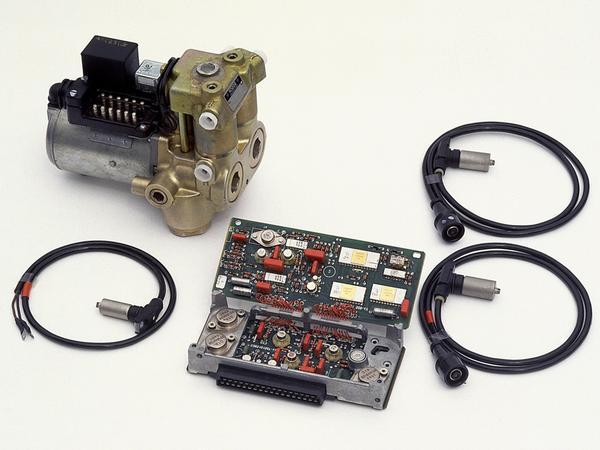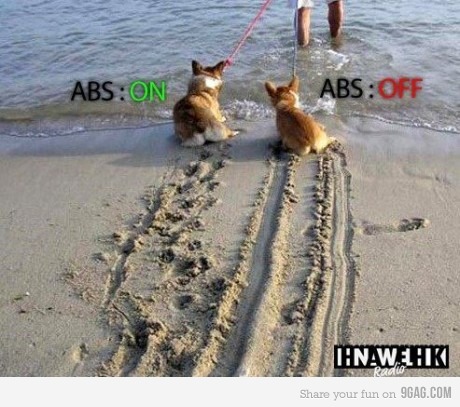What are anti-lock brakes? PH Explains
Standing on the brakes and still able to steer? You've ABS to thank for that

An anti-lock braking system is designed to prevent a car's wheels from locking up and skidding, even when maximum braking power is being applied. This has several benefits, the most prominent of which are improved stability and handling during emergency braking. This is primarily because, as the wheels are not skidding, the driver can still steer the car in an effort to avoid obstacles.
Modern systems also reduce stopping distances in emergency situations, as they are capable of quickly and effortlessly delivering the maximum available stopping power at each individual wheel without locking them up.
These systems are often dubbed 'ABS', an acronym reputedly derived from 'Anti-Blockier System' - the German name for the first mass-produced automotive anti-lock braking system. The acronym is also widely accepted to stand for 'Anti-lock Braking System'.

How do anti-lock brakes work?
Modern ABS set-ups typically monitor the speed of each wheel and rely on an electronic control unit, a series of valves and a hydraulic pump. These, working together, allow the system to correctly modulate the brake pressure at each wheel.
When the brakes are applied, the system looks at the wheel speeds. If one wheel starts slowing more quickly than the others, suggesting that it is about to lock and slide, the control unit will send signals to an electronically controlled valve regulating brake pressure at that wheel's caliper.
This solenoid valve allows the pressure at that wheel to be reduced until it starts turning again, at which point brake pressure is increased by the pump in order to maintain maximum stopping power. This cycle repeats until the wheels cease locking up or the pressure on the brake pedal is released. Bosch, for example, states that its systems can carry out this cycle up to 40 times a second.
Consequently, an ABS-equipped car can keep every wheel from locking up when the driver stands on the brakes, maintaining steering control and delivering quick, strong and consistent stopping power. The system also grants reliable, controlled braking when slowing on rougher, slippier surfaces.

A brief history of anti-lock brakes
The concept of an anti-lock braking system was first detailed in 1908, with the aim being to stop heavy locomotives skidding and damaging the track or crashing. A French Lieutenant called Pierra Cayla then proposed an anti-lock system for cars in 1923, which was designed to reduce wheel lock and improve steering control in emergency situations.
ABS was first employed in earnest, however, in aircraft. The invention of the jet engine had resulted in heavier, faster aircraft that were harder to land and more demanding on the pilots and tyres. Advances in technology permitted Boeing to equip its B-47 Stratojet with ABS in 1947; a Maxaret system, from Dunlop, was also employed in the 1952 Avro Vulcan.
The technology began filtering back into cars in the 1950s but it wasn't until 1966 that the first production car with ABS arrived, in the form of the Jensen FF. Chrysler then followed in 1970, with the Bendix 'Sure-Brake' set-up, before Mercedes-Benz introduced ABS to a wider audience in 1978. Just 10 years later, around one million Mercedes vehicles were equipped with the life-saving system.
Anyway, it missed out one way in which ABS works on modern cars, the ECU knows lots of details about the car and so as it monitors wheel speed if it detects that the wheels are slowing down more is possible (ie not just comparing them) it will release the brakes... and them reapply them etc. They know about the size of the brake pistons and exactly how much fluid is needed along with the latency in the system. This is one way where upgrading to much bigger/better brakes may cause issues. It can confuse the ABS at the limit and cause it to underbrake.
Modern ones however also learn from how the car actually performs and will tailor their response to how the system actually behaves rather than how it should.
Modern systems now as well do clever EBD/EBL (Electronic Brake Distribution/Electronic Brakeforce Limitation) which allows the braking force to be redistributed, typically combined with the DSC /ESC.
These 'Explains' features are just straightforward, short introductory pieces on the tech or hardware in question, for those unfamiliar with them – so you will see similar topics from time to time (for example, one Explains on supercharging, followed much later by an Origins piece). Hope that all makes sense!
Anyway, it missed out one way in which ABS works on modern cars, the ECU knows lots of details about the car and so as it monitors wheel speed if it detects that the wheels are slowing down more is possible (ie not just comparing them) it will release the brakes... and them reapply them etc. They know about the size of the brake pistons and exactly how much fluid is needed along with the latency in the system. This is one way where upgrading to much bigger/better brakes may cause issues. It can confuse the ABS at the limit and cause it to underbrake.
Modern ones however also learn from how the car actually performs and will tailor their response to how the system actually behaves rather than how it should.
Modern systems now as well do clever EBD/EBL (Electronic Brake Distribution/Electronic Brakeforce Limitation) which allows the braking force to be redistributed, typically combined with the DSC /ESC.
Anyway, it missed out one way in which ABS works on modern cars, the ECU knows lots of details about the car and so as it monitors wheel speed if it detects that the wheels are slowing down more is possible (ie not just comparing them) it will release the brakes... and them reapply them etc. They know about the size of the brake pistons and exactly how much fluid is needed along with the latency in the system. This is one way where upgrading to much bigger/better brakes may cause issues. It can confuse the ABS at the limit and cause it to underbrake.
Modern ones however also learn from how the car actually performs and will tailor their response to how the system actually behaves rather than how it should.
Modern systems now as well do clever EBD/EBL (Electronic Brake Distribution/Electronic Brakeforce Limitation) which allows the braking force to be redistributed, typically combined with the DSC /ESC.
 I was looking into this in some depth when I was wondering if ABS/DSC could be repurposed for a kit car and specifically looking at the Bosch 5.7 DSC III.... and decided it wasn't a wise idea as the weight, dimensions and brake setup varied so much from the base/donor that how it would behave would be somewhat unpredictable.
I was looking into this in some depth when I was wondering if ABS/DSC could be repurposed for a kit car and specifically looking at the Bosch 5.7 DSC III.... and decided it wasn't a wise idea as the weight, dimensions and brake setup varied so much from the base/donor that how it would behave would be somewhat unpredictable. 

Gassing Station | General Gassing | Top of Page | What's New | My Stuff




